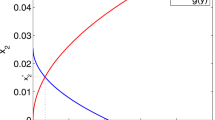Abstract
In this paper, a ratio-dependent predator–prey model with stage structure in the prey is constructed and investigated. In the first part of this paper, some sufficient conditions for the existence and stability of three equilibriums are obtained. In the second part, we consider the effect of impulsive release of predator on the original system. A sufficient condition for the global asymptotical stability of the prey-eradication periodic solution is obtained. We also get the condition, under which the prey would never be eradicated, i.e., the impulsive system is permanent. At last, we give a brief discussion.
Similar content being viewed by others
References
Arditi, R., Saiah, H.: Empirical evidence of the role of heterogeneity in ratio-dependent consumption. Ecology 73, 1544–1551 (1992)
Arditi, R., Ginzburg, L.R., Akcakaya, H.R.: Variation in plankton densities among lakes: A case for ratio-dependent models. Am. Nat. 138, 1287–1296 (1991)
Gutierrez, A.P.: The physiological basis of ratio-dependent predator–prey theory: A metabolic pool model of Nicholson’s blowflies as an example. Ecology 73, 1552–1563 (1992)
Arditi, R., Ginzburg, L.R.: Coupling in predator–prey dynamics: ratio-dependence. J. Theor. Biol. 139, 311–326 (1989)
Hanski, I.: The functional response of predator: Worries about scale. Trends Ecol. Evol. 6, 141–142 (1991)
Ding, X.Q., Jiang, J.F.: Multiple periodic solutions in delayed Gause-type ratio-dependent predator–prey systems with non-monotonic numerical responses. Math. Comput. Model. 47, 1323–1331 (2008)
Song, X., Cai, L., Neumann, A.U.: Ratio-dependent predator–prey system with stage structure for prey. Discrete Continuous Dyn. Syst. Ser. B 4(3), 747–758 (2004)
Xu, R., Chaplain, M.A.J., Davidson, F.A.: Persistence and global stability of a ratio-dependent predator–prey model with stage structure. Appl. Math. Comput. 158, 729–744 (2004)
Wang, Y.M.: Numerical solutions of a Michaelis–Menten type ratio-dependent predator–prey system with diffusion. Appl. Numer. Math. 59(5), 1075–1093 (2009)
Xu, R., Ma, Z.: Stability and Hopf bifurcation in a ratio-dependent predator–prey system with stage structure. Chaos Solitons Fractals 38, 669–684 (2008)
Kiss, K., Kovács, S.: Qualitative behavior of n-dimensional ratio-dependent predator–prey systems. Appl. Math. Comput. 199, 535–546 (2008)
Xiao, Y.N., Chen, L.S.: A ratio-dependent predator–prey model with disease in the prey. Appl. Math. Comput. 131, 397–414 (2002)
Lakshmikantham, V., Bainov, D.D., Simeonov, P. (eds.): Theory of Impulsive Differential Equations. World Scientific, Singapore (1989)
Bainov, D., Simeonov, P. (eds.): Impulsive Differential Equations: Periodic Solutions and Applications. Pitman Monographs and Surveys in Pure and Applied Mathematics, vol. 66. Pitman, London (1993)
Zavalishchin, S.T., Sesekin, A.N.: Dynamic Impulse Systems. Theory and Applications. Kluwer Academic, Dordrecht (1997)
Wang, W., Shen, J., Nieto, J.: Permanence and periodic solution of predator–prey system with Holling type functional response and impulses. Discrete Dyn. Nat. Soc. 2007, Article ID 81756 (2007), 15 pp.
Zhang, H., Chen, L., Nieto, J.: A delayed epidemic model with stage-structure and pulses for pest management strategy. Nonlinear Anal. Real World Appl. 9(4), 1714–1726 (2008)
Georgescu, P., Morosanu, G.: Pest regulation by means of impulsive controls. Appl. Math. Comput. 190, 790–803 (2007)
Shi, R.Q., Chen, L.S.: Stage-structured impulsive SI model for pest management. Discrete Dyn. Nat. Soc. 2007, Article ID 97608 (2007), 11 pp.
Shi, R.Q., Chen, L.S.: Staged-structured Lotka–Volterra predator–prey models for pest management. Appl. Math. Comput. 203, 258–265 (2008)
Aiello, W.G., Freedman, H.I.: A time delay model of single-species growth with stage structure. Math. Biosci. 101, 139–153 (1990)
Aiello, W.G., Freedman, H.I., Wu, J.: Analysis of a model representing stage structured population growth with state-dependent time delay. SIAM J. Appl. Math. 52, 855–869 (1992)
Song, X.Y., Chen, L.S.: Modelling and analysis of a single-species system with stage structure and harvesting. Math. Comput. Model. 36, 67–82 (2002)
Song, X.Y., Chen, L.S.: Optimal harvesting and stability for a predator–prey system with stage structure. Acta Math. Appl. Sin. 18, 423–430 (2002)
Wang, W.D., Chen, L.S.: A predator–prey system with stage-structure for predator. Comput. Math. Appl. 33, 83–91 (1997)
Liu, S.Q., Chen, L.S., Liu, Z.J.: Extinction and permanence in nonautonomous competitive system with stage structure. J. Math. Anal. Appl. 274, 667–684 (2002)
Xiao, Y.N., Chen, L.S.: Stabilizing effect of cannibalism on a structured competitive system. Acta Math. A 22(2), 210–216 (2002). (In Chinese)
Song, X.Y., Chen, L.S.: Optimal harvesting and stability for a two-species competitive system with stage structure. Math. Biosci. 170(2), 173–186 (2001)
Xiao, Y.N., Chen, L.S.: An SIS epidemic models with stage structure and a delay. Acta Math. Appl. Sin., Engl. Ser. 18(4), 607–618 (2002)
Xiao, Y.N., Chen, L.S.: On an SIS epidemic model with stage structure. J. Syst. Sci. Complex. 16, 275–288 (2003)
Xiao, Y.N., Chen, L.S., Bosh, F.V.D.: Dynamical behavior for stage-structured SIR infectious disease model. Nonlinear Anal. Real World Appl. 3, 175–190 (2002)
Author information
Authors and Affiliations
Corresponding author
Rights and permissions
About this article
Cite this article
Shi, R., Chen, L. The study of a ratio-dependent predator–prey model with stage structure in the prey. Nonlinear Dyn 58, 443–451 (2009). https://doi.org/10.1007/s11071-009-9491-2
Received:
Accepted:
Published:
Issue Date:
DOI: https://doi.org/10.1007/s11071-009-9491-2




